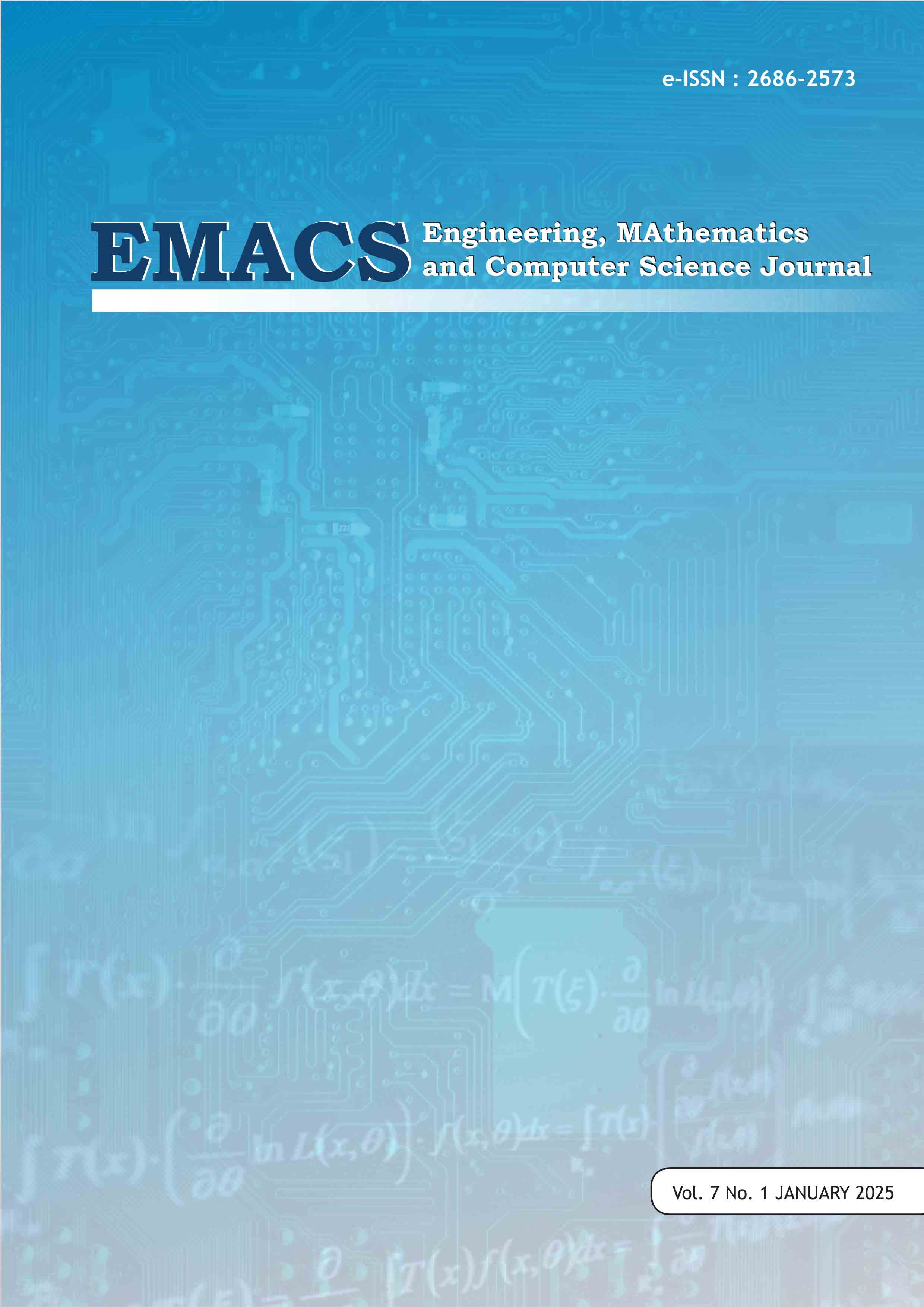Indoor Positioning System using Gaussian Mixture Model on BLE Fingerprint
DOI:
https://doi.org/10.21512/emacsjournal.v7i1.12581Keywords:
Bluetooth Low Energy, ; Frequency Distribution Radio Map, Probabilistic Fingerprinting, Gaussian Mixture ModelAbstract
After the release of Bluetooth Low Energy (BLE), people have been trying to use Bluetooth as an alternative source to solve indoor positioning. Unfortunately, due to the nature of Bluetooth about proximity, the propagated signal is very fluctuating. This decreases the accuracy considerably and has become one of the main problems in using Bluetooth. To combat the signal fluctuations, we propose a fingerprinting-based concept of using received signal strength (RSS) frequency distribution values as the data in the radio map, which is termed Frequency Distribution Radio Map (FDRM). We also propose a probabilistic fingerprinting-based algorithm utilizing FDRM using Gaussian Mixture Model (GMM) as the probability distribution function (PDF). In the offline phase, we compare 2 methods: k-Means only, and k-Means with Expectation-Maximization (EM); to learn the FDRM. This resulting a probability distribution function (PDF) of the RSS in each reference points for each BLEs. In the online phase, k-Nearest Neighbour (KNN) and weighted average are used to estimate the receiver’s location. The proposed method is validated over 3 different datasets taken from a 4 m x 6 m classroom equipped with chairs and tables. The experiment shows that the proposed fingerprint and model are better in capturing the environment, including the signal fluctuation. By using only k-Means in obtaining the GMM, it achieved mean error of 98.18 cm and standard deviation of 56.11 cm. By adding EM, there will be a trade-off between mean error with better standard deviation and lower computing time. It achieved standard deviation of 47.99 cm and mean error of 112.24 cm.
References
Alfakih, M., Keche, M., & Benoudnine, H. (2015). Gaussian Mixture Modeling for Indoor Positioning WIFI System. 2015 3rd International Conference on Contro, Engineering & Information Technology (CEIT). Tlemcen.
Bahl, P., & Padmanabhan, V. N. (2000). RADAR: An In-Building RF-based User Location and Tracking System. Proceedings IEEE INFOCOM 2000. Conference on Computer Communications. Nineteenth Annual Joint Conference of the IEEE Computer and Communications Societies (Cat. No.00CH37064). Tel Aviv, Israel.
Chandel, V., Ahmed, N., Arora, S., & Ghose, A. (2016). InLoc: An end-to-end robust indoor localization and routing solution using mobile phones and BLE beacons. 2016 International Conference on Indoor Positioning and Indoor Navigation (IPIN). Alcala de Henares.
Chung-Hao Huang, L.-H. L.-L.-H. (2015). Real-Time RFID Indoor Positioning System Based on Kalman-Filter Drift Removal and Heron-Bilateration Location Estimation. IEEE Trans. Instrumentation and Measurement, 64(3), 728-739.
Fisher, J. A. (2006). Indoor positioning and digital management: Emerging surveillance regimes in hospitals. In Surveillance and Security: Technological Politics and Power in Everyday Life (pp. 89-100). Abingdon: Routledge.
Gomez, C., Oller, J., & Paradells, J. (2012). Overview and Evaluation of Bluetooth Low Energy: An Emerging Low-Power Wireless Technology. Sensors, 12(9), 11734-11753.
Goswami, A., Ortiz, L. E., & Das, S. R. (2011). WiGEM: a learning-based approach for indoor localization. CoNEXT '11 Proceedings of the Seventh COnference on emerging Networking EXperiments and Technologies. Tokyo.
Han, T., Lu, X., & Lan, Q. (2010). Pattern recognition based Kalman filter for indoor localization using TDOA algorithm. Applied Mathematical Modelling, 34(10), 2893-2900.
Haque, I. T. (2014). A sensor based indoor localization through fingerprinting. Journal of Network and Computer Applications, 44, 220-229.
Hossain, A. K., & Soh, W.-S. (2015). A Survey of Calibration-free Indoor Positioning Systems. Computer Communications, 66, 1-13.
Ke, C., Wu, M., Chan, Y., & Lu, K. (2018). Developing a BLE Beacon-Based Location System Using Location Fingerprint Positioning for Smart Home Power Management. Energies, 11(12), 3464.
Kim, S.-C., Jeong, Y.-S., & Park, S.-O. (2013). RFID-based indoor location tracking to ensure the safety of the elderly in smart home environments. Personal and ubiquitous computing, 17(8), 1699-1707.
Lee, C. (2004). Indoor positioning system based on incident angles of infrared emitters. 30th Annual Conference of IEEE Industrial Electronics Society, 2004. IECON 2004. Busan, South Korea.
Li, H. (2014). Low-Cost 3D Bluetooth Indoor Positioning with Least Square. Wireless Personal Communications, 78(2), 1331-1344.
Mandal, A., Lopes, C. V., Givargis, T., Haghighat, A., Jurdak, R., & Baldi, P. (2005). Beep: 3D Indoor Positioning Using Audible Sound. IEEE Consumer Communications and Networking Conference (CCNC’05). Las Vegas.
Medina, C., Segura, J. C., & Torre, Ã. l. (2013). Ultrasound Indoor Positioning System Based on a Low-Power Wireless Sensor Network Providing Sub-Centimeter Accuracy. Sensors, 13(3), 3501-3526.
Mendelson, E. (2014, October 21). U.S. Patent No. 8,866,673.
Onofre, S., Silvestre, P. M., Pimentão, J. P., & Sousa, P. (2016). Surpassing Bluetooth Low Energy Limitations on Distance Determination. 2016 IEEE International Power Electronics and Motion Control Conference (PEMC). Varna.
Papapostolou, A., & Chaouchi, H. (2011). RFID-assisted indoor localization and the impact of interference on its performance. Journal of Network and Computer Applications, 34(3), 902-913.
Paterna, V. C., Auge, C. A., Aspas, J. P., & Bullones, M. A. (2017). A Bluetooth Low Energy Indoor Positioning System with Channel Diversity, Weighted Trilateration and Kalman Filtering. Sensors, 17(12), 2927.
Prashant, K., M, N. A., Shreyas, N., Chaithanya, N., & Kuttaiah, P. (2009). Gaussian Mixture Model-Expectation Maximization based Signal Strength Prediction for Seamless Connectivity in Hybrid Wireless Networks. MoMM '09 Proceedings of the 7th International Conferencee on Advances in Mobile Computing and Multimedia. Kuala Lumpur, Malaysia.
Pu, Y., & You, P. (2018). Indoor Positioning System Based on BLE Location Fingerprinting with classification approach. Applied Mathematical Modelling, 62, 654-663.
Ramani, S. V., & Tank., Y. N. (2014). Indoor Navigation On Google Maps And Localization Using RSS Fingerprinting. International Journal of Engineering Trends and Technology, 11(4), 171-173.
Ruggiero, L., Charith, D., Song, X., & Lucia, B. (2018). Investigating pedestrian navigation in indoor open space environments using big data. Applied Mathematical Modelling, 62, 499-509.
Shin, B., Lee, J. H., Lee, T., & Kim, H. S. (2012). Enhanced weighted K-nearest neighbor algorithm for indoor Wi-Fi positioning systems. 2012 8th International Conference on Computing Technology and Information Management (NCM and ICNIT). Seoul.
Wang, X., Gao, L., & Mao, S. (2017). CSI Phase Fingerprinting for Indoor Localization. IEEE Internet of Things Journal, 3(6), 1113-1123.
Wang, X., Gao, L., Mao, S., & Pandey, S. (2015). DeepFi: Deep Learning for Indoor Fingerprinting Using Channel State Information. 2015 IEEE wireless communications and networking conference (WCNC). New Orleans.
Wang, Y., Yang, X., Zhao, Y., Liu, Y., & Cuthbert, L. (2013). Bluetooth Positioning using RSSI and Triangulation Methods. 2013 IEEE 10th Consumer Communications and Networking Conference (CCNC). Las Vegas.
Wong, C., Klukas, R., & Messier, G. G. (2008). Using WLAN infrastructure for angle-of-arrival indoor user location. 2008 IEEE 68th Vehicular Technology Conference. Calgary.
Woo, S., Jeong, S., Mok, E., Xia, L., Choi, C., Pyeon, M., & Heo, J. (2011). Application of Wifi-based Indoor Positioning System For Labor Tracking At Construction Sites A Case Study In Guangzhou MTR. Automation in Construction, 20(1), 3-13.
Yang, J., Wang, Z., & Zhang, X. (2015). An iBeacon-based Indoor Positioning Systems for Hospitals. International Journal of Smart Home, 9(7), 161-168.
Yang, Z., Wu, C., & Liu, Y. (2012). Locating in Fingerprint Space: Wireless Indoor Localization with Little Human Intervention. Proceedings of the 18th annual international conference on Mobile computing and networking. Istanbul.
Downloads
Published
How to Cite
Issue
Section
License
Copyright (c) 2025 Maximilianus Maria Kolbe Lie, Bakti Amirul Jabar

This work is licensed under a Creative Commons Attribution-ShareAlike 4.0 International License.
Authors who publish with this journal agree to the following terms:
- Authors retain copyright and grant the journal right of first publication with the work simultaneously licensed under a Creative Commons Attribution License - Share Alike that allows others to share the work with an acknowledgment of the work's authorship and initial publication in this journal.
- Authors are able to enter into separate, additional contractual arrangements for the non-exclusive distribution of the journal's published version of the work (e.g., post it to an institutional repository or publish it in a book), with an acknowledgment of its initial publication in this journal.
- Authors are permitted and encouraged to post their work online (e.g., in institutional repositories or on their website) prior to and during the submission process, as it can lead to productive exchanges, as well as earlier and greater citation of published work.
USER RIGHTS
All articles published Open Access will be immediately and permanently free for everyone to read and download. We are continuously working with our author communities to select the best choice of license options, currently being defined for this journal as follows: Creative Commons Attribution-Share Alike (CC BY-SA)





